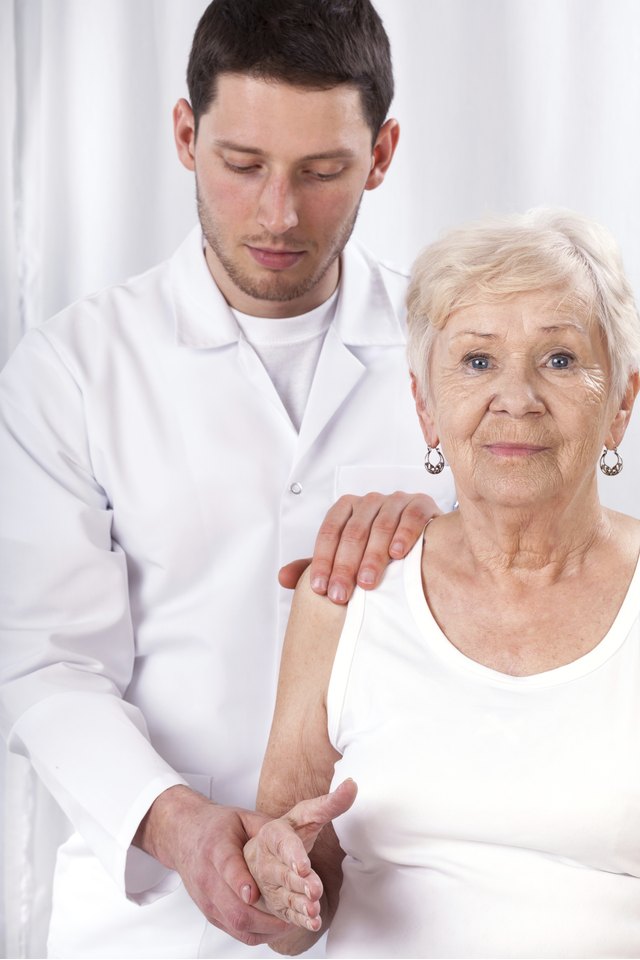Exercises for Treatment of Brachial Neuritis

Brachial neuritis is an inflammation of your shoulder area nerves, resulting in upper arm and shoulder weakness plus varying pain levels. Exercises for treatment of brachial neuritis concentrate on restoring and maintaining muscle strength and flexibility to your neck, shoulder and elbow area. Not all exercises may fit your health condition, so check with your doctor before starting any.
Passive Swings
Exercises for treatment of brachial neuritis need to include passive range of motion maneuvers that aid in reducing pain levels associated with the condition, according to MD Guidelines. Start doing a passive shoulder exercise known as a pendulum swing. Stand upright alongside a firm chair and gently bend your knees, according to the Nicholas Institute of Sports Medicine and Athletic Trauma. Hold onto the chair for support purposes with your uninjured hand. Gently bend from the waist and let your injured arm hang freely to stretch your muscles. Slowly move your upper body to start your arm moving like a pendulum. Swing your arm in five clockwise circles. Stop and relax 20 seconds. Repeat the exercise in a counterclockwise direction.
Wall Pushers
Restoring your shoulder and elbow strength plays a key role in returning your arm to a proper functioning level. Isometric exercises for treatment of brachial neuritis provide a gentle way to increase muscle strength. Start doing some wall-based shoulder extensions by standing with your back against a wall. Place your injured arm onto the wall, palm open and flat against the wall. Gently push your hand into the wall, according to the American Academy of Orthopaedic Surgeons. Hold tension five seconds. Release tension. Relax 10 seconds. Repeat the exercise 10 times.
Overhead Stretches
Gently flexing your shoulder area fits in nicely with exercises for treatment of brachial neuritis. You can start increasing your shoulder area range of motion by doing some active stretching maneuvers, according to the American Academy of Orthopaedic Surgeons. Begin by standing upright or sitting in a firm chair. Slowly lift your injured arm toward the ceiling. Hold position 10 seconds. Slowly return to original position. Relax 10 seconds. Repeat 10 times.
Head Turning
Exercises for treatment of brachial neuritis must concentrate on returning range of motion to your neck area, according to MD Guidelines. Accomplish this goal by doing some neck rotation maneuvers. Sit upright in a firm chair. Slowly turn your head to the right without turning your back. Hold the position for 10 seconds. Slowly return to center position. Repeat the exercise five times. Do the exercise again to your left.
Forearm Turning
Increase your shoulder range of motion by including some rotational maneuvers in your exercises for treatment of brachial neuritis routine. Sit upright in a firm chair next to a waist-high table. Keep your shoulder blades together. Gently place your injured arm onto a table while bending your elbow to a 90-degree angle, according to the American Academy of Orthopaedic Surgeons. Slowly move your forearm away from you while keeping your elbow at your side. Hold five seconds. Slowly return to the original position. Relax 10 seconds. Repeat the exercise 10 times.
References
Writer Bio
Crystal Welch has a 30-year writing history. Her more than 2,000 published works have been included in the health and fitness-related Wellness Directory, Earthdance Press and Higher Source. She is an award-winning writer who teaches whole foods cooking and has written a cookbook series. She operates an HON-code-certified health-related blog with more than 95,000 readers. Welch has a B.B.A. from Eastern Michigan University.
